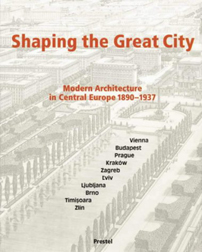Shaping the Great City: Modern Architecture in Central Europe 1890-1937
 The explosion of architectural ideas during the last decades of the Hapsburg Empire and in the first adventurous years of the new republics of Central Europe that followed it is the subject of this stimulating and wide-ranging study. Despite the cultural battleground of competing linguistic, ethnic, religious, and national traditions and aspirations, the region was nevertheless host to a persistent cosmopolitan ideal. This publication looks at the city as both the principal site of innovation and experimentation in the period, and the generator of a vibrant urban culture.
The explosion of architectural ideas during the last decades of the Hapsburg Empire and in the first adventurous years of the new republics of Central Europe that followed it is the subject of this stimulating and wide-ranging study. Despite the cultural battleground of competing linguistic, ethnic, religious, and national traditions and aspirations, the region was nevertheless host to a persistent cosmopolitan ideal. This publication looks at the city as both the principal site of innovation and experimentation in the period, and the generator of a vibrant urban culture.
Shaping the Great City examines the distinctive character, composition, and cultural dynamics of place and the importance of the city in defining and expressing identity. It addresses the astonishing range of architectural searching and experiment that took place in Vienna, Budapest, and Prague, as well as in other cities, such as Lemberg, Cracow, Zagreb and Ljubljana, and reviews the urban architectural ideas of Otto Wagner, Camillo Sitte, Adolf Loos, Max Fabiani, Joze Plecnik, also drawing attention to less well-known 20th-century modernists. The book is richly illustrated with drawings, prints, photographs, and models drawn from archives and museums throughout the region, as well as the books, journals, and manifestos that circulated these new ideas.
Prestel